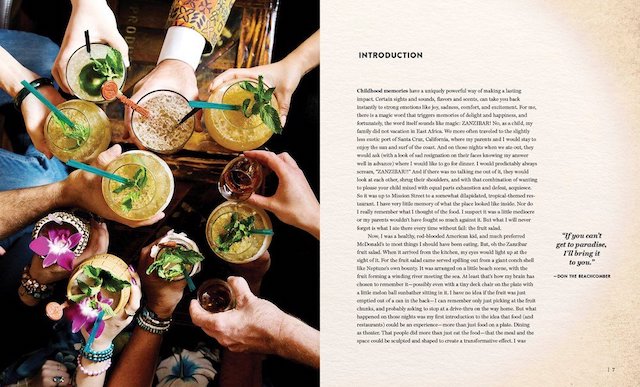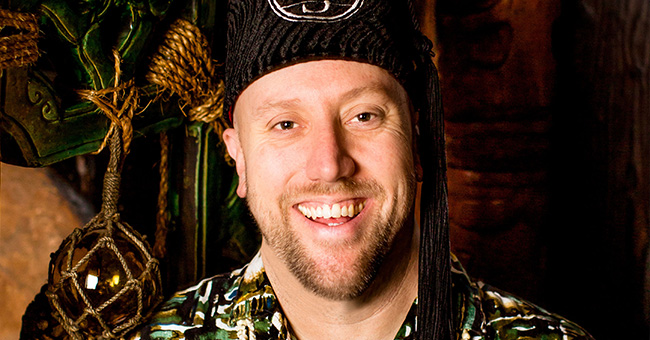Collectible porcelain mugs. Nine ingredients in one serving. Cocktails with funny names and that signature splash of pineapple. To the average bar patron, this is the essence of tiki culture. But to Martin Cate, creator of San Francisco’s world-famous Smuggler’s Cove, there is much more to tiki than syrupy sweet drinks, tiny umbrellas and vintage Hawaiian shirts. There’s a deep, rich history rooted in Polynesian pop culture and an exciting horizon for where this niche of cocktail culture could go next. And, luckily for those of us who are curious enough to dabble (or go deep) into this cult of exotic cocktails, there’s now the ultimate book of all things tiki. Thanks to Martin Cate, of course.
“It’s a three pounder — long and dense,” Cate jokes as he describes just how much went into researching, recipe testing and writing his upcoming “Smuggler’s Cove: Exotic Cocktails, Rum, and the Cult of tiki.” We sat down with Cate to learn more about what we can expect in the expansive book and what inspired him to publish in the first place.
First of all, where did your obsession with tiki first start?
The first time I ever went to a tiki bar was at Trader Vic’s in Washington, D.C. in 1994. That night spurned a love for me, because it was such a different experience. You’re in the basement of this austere hotel and you walk through this rift of bamboo and thatch and funky globe lights and just… crazy stuff. It was this amazing contrast. I found myself getting more involved in the tiki community — learning from those who were really into the historic drinks created decades ago. It wasn’t until the late ‘90s that my passion really took off: I started playing around with vintage classic recipes and started to understand why one drink would ask for three different rums from three different countries. I would try the rum to see how they taste and figure out why they were so completely different. That’s how I started to really dig in. You end up uncovering this vast, fascinating history of rum. And that history played a vital role in the development of Smuggler’s Cove before we opened.
So, at this point in your life, why did you decide to write a book?

There are a bunch of really great books about the history of tiki that cover the cult fascination of the past and present. But I never really found the kind of book I wanted on the subject. I was looking for something that was less about where tiki has been and more about where it’s going. So my wife Rebecca and I decided we wanted to celebrate the past in a way that sort of codifies the drinks in a more sensical way and that discusses the drinks themselves and how they fit into a broader picture of Polynesian pop culture — a fad that lasted for decades of movie and art. I also wanted to kind of bring that cult knowledge to a broader audience of cocktail enthusiasts who want to learn from that history and continue to evolve the category. I explain where it all came from and why it looks the way it does today. Then I put that into context so that when people want to move forward with the next evolution, they have some roots to hold onto. What we hope to do is provide further inspiration to fuel the fire of further revival.
You talk about the future of this tiki revival. Where do you see this all going?
Well, I don’t have a crystal ball, but I do see a lot of tiki bars opening. So obviously the interest is out there. We’re seeing guests really enjoy the experience of escape that comes with tiki. It’s less serious than what we’ve grown accustomed to over the last few years in the world of craft cocktail culture. Tiki has this levity and fun, but the creation and execution is still very serious.
What can we expect in the book?
The book is broken down into a series of chapters. First, we cover where tiki came from, why it looks the way it does, and how it was revived. Then we go into how to create your own tiki experience, whether that is in a restaurant bar or at home. We talk about Smuggler’s Cove and how we developed the space but also, if you’re just an at-home enthusiast, there is advice about finding the right kinds of rum and traditional ingredients that stay true to the roots. We talk about how to execute a space, how to look for building materials, design and music … even how to throw the ultimate tiki party in your backyard. We also included over 100 recipes for people to try their hands at, including new recipes from the Smuggler’s Cove team that have never been published, that were created just for this book. We also put together a new method of classifying rums. I wanted to do it in a way that makes more sense. Rather than using the outdated and vague terminology currently used to categorize rum, we have created a system based on production method. “Gold rum” doesn’t really mean anything anymore. So we created a guide to help consumers get their heads around how rum is made and why it tastes the way it does and why producers do what they do. It really does give a better sense for just how diverse — and confusing — rum really is.
What was the process like of putting this book together?
It took a couple of years. We kicked off the idea to write this back in 2013, but we didn’t really start writing until 2014. We wanted to do something that had a broad mission, but we took the details very seriously. We traveled the country, doing research and meeting with these “keepers” of tiki culture — those people who take it very seriously, or who have created something new with it. We wanted to learn every bit of tiki culture that we could, that we didn’t know about already. We took photographers with us to capture these stories—everything from at-home basement bars and backyard set-ups to famous tiki bars and tiki-themed events around the country. Turns out, there was a lot of ground to cover. We had illustrators, designers and photographers who helped us bring everything to life. So it was a labor of love across a lot of disciplines.
Any plans for more cocktail books in the future?
Honestly, this is all I can imagine right now.
“Smuggler’s Cove: Exotic Cocktails, Rum, and the Cult of Tiki” is available June 7th in bookstores and is available now for pre-order on Amazon and at Barnes & Noble.





